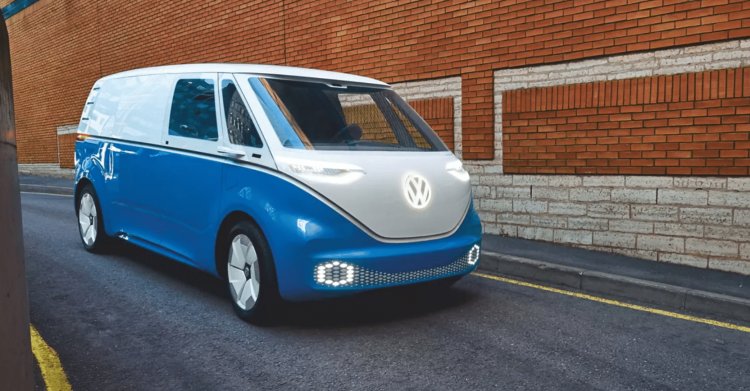Volkswagen family expands with the Buzz model

The first electric ID. Buzz models are due by the end of the year, and they will be driven by a 150 kW electric motor fueled by a lithium-ion battery with a net capacity of 77 kWh.
Electrified mobility also entails lowering exhaust emissions throughout the entire value chain. CO2 emissions per vehicle in Europe will be cut by 40% by 2030. Volkswagen's 'Way to Zero' strategy aims to make the company's balance sheet climate-neutral by 2050 at the latest.
The focus of this 'road to zero' is the new Accelerate brand strategy's the faster strengthening of the electric offensive.
VW aims to boost the share of completely electric cars in total vehicle sales to at least 70% in Europe by 2030, and at least 50% in North America and China.
As a result, the ID is fast spreading.
Volkswagen introduced the ID concept car at the Detroit Motor Show more than five years ago. That distant past is now becoming a reality. The favorable feedback from the first screening encouraged the decision to begin mass manufacture of the model, which will be available as a delivery ID.
In addition to the five-seater model, Buzz Cargo is available.
The first delivery electric edition has received as much interest as the ID.3 model, the first electric VW of the new generation. The resemblance to the renowned T1 model, the first Bulli model, is clearly apparent.
The debut was streamed live from Hanover, Germany, where the first Bulli copies were manufactured. ID will also be created here. Volkswagen's commercial vehicle department has demonstrated yet again that it is working on all aspects of the green transition.
As a result, the hangar where the presentation was conducted on the top is paved with solar panels, demonstrating that they cut exhaust emissions.
Primarily, we mean short body overhangs, maximum utilization of space on a minimum surface, the classic separation of body design into lower and upper levels, and the unmistakable front of the vehicle in the shape of the letter V. ID. Buzz, like the earlier model Bulli, features rear-wheel drive.
Otherwise, ID. Buzz isn't the first Bulli to be powered by electricity. Volkswagen introduced the T2 at the Hanover trade exhibition 50 years ago as the first prototype powered by an electric motor in the rear of the car.
However, the maximum range of 85 kilometers demonstrates that battery technology is still far from being ready for practical use. However, the desire for a Bulli model with no exhaust emissions began as early as 1972. However, it is becoming a reality this year.
Compact and very spacious
The Buzz Cargo, with a standard wheelbase of 298.8 millimeters, is the first vehicle to join the market. This model's overall length is only 471.2 cm. The wheelbase is only two millimeters longer than the wheelbase of the T6.1 model, which has a total length of 490.4 cm. ID. Buzz has a comparable internal length but can park in smaller areas. The widely glazed passenger model stands 193.7 cm tall.
Because of minor variations in rolling stock, the freight is a millimeter greater (T6.1: 197 cm). The ID. Buzz model's width is 198.5 cm (without exterior mirrors). As a result, the new model is 8.1 cm broader than the T6.1. The eye-catching style is matched by huge wheels with rim widths ranging from 18 to 21 inches. The turning circle is 11.1 meters in diameter.
All of this indicates that ID Buzz is a well-known model. Both versions feature rarely seen space utilization thanks to the tiny modular electric platform (MEB) design. In the model ID. When all seats are occupied, the five-seater Buzz can accommodate up to 1,121 liters of luggage. The usable volume grows to 2205 liters when folding the rear seats. The ID model's maximum volume.
Buzz Cargo has a partition wall behind the first row of seats and has a volume of more than 3.9 cubic meters. This implies that it will receive two euro pallets. A driver's seat or a bench for two adjacent to the driver can be selected here. Over the coming year, we can anticipate a model with a longer wheelbase and larger interior dimensions.
Attractive and modern design is complemented by practical solutions
When it makes it to the ID market. Buzz will be available in seven monochromes and four two-tone color combinations. This combination of white and new color hues is also noticeable on the inside, which carries over stylistic features from the T1 model generation into today's era of electric mobility. The hues match the body color and may be found on the seating surfaces, instrument panel, and door trim.
Special experiences will be handled by ambient lighting (which can be customized to be as many as 30 different hues). Such as several Škoda models and ID. Buzz should put together some useful tools or help. ID would agree. Buzz should include a bottle opener as well as an ice-scraper.
Volkswagen employs appropriate materials in the previously mentioned 'Way to Zero' mission. Volkswagen employs a suite of innovative technology and techniques, in this case, making both models among the most environmentally friendly in the world.
Leather and other animal-derived materials are fully avoided and substituted with materials that have similar features and feel. As a result, the steering wheel is composed of polyurethane, but it looks and feels just like leather.
Model ID seat covers, floor coverings, and roof coverings. Among the materials utilized in Buzz are recyclables - materials made from discarded products.
More and more environmentally friendly materials
For example, one fabric will be composed of Seaqual material, with threads made up of around 10% collected marine plastic and 90% PES (recycled PET bottles). When compared to comparable items, this can cut CO2 emissions by 32%. For the first time in the concern's ID model, ArtVelours'ECO' was employed. Buzz is likewise made up of 71% recycled material.
Buzz, like other well-known IDs, is built on the Volkswagen Group's modular electric platform (MEB). The initial models will be powered by a 150 kW electric motor built into the back axle. It is powered by a lithium-ion high-voltage battery with a gross energy content of 82 kWh and a net energy content of 77 kWh.
The top speed is electrically limited to 145 km/h. From a standstill, this e-engine produces a maximum torque of 310 Nm. The battery is placed in the lowest position on the sandwich floor to achieve a low center of gravity.
The lithium-ion battery can be charged using 11 kW AC from wall boxes or public chargers (AC). The charging power at the DC fast charging station is raised to 170 kW via the CCS socket. The battery charge level goes from 5 to 80 percent in roughly 30 minutes when charged in this manner.
New IDs are assigned. In the future, the software will also have the Plug & Charge function. This means that after connecting the connectors, many service providers will have automatic car synchronization and DC charging stations.
As a result, transmitting all relevant information with the charging point will substantially simplify the charging station's use. This means that no extra application or identity card will be required.
ID. Buzz can also restore electricity
The ID model's fascination. Buzz has a new feature as well: two-way charging. This technology brings up a whole new world of possibilities. For example, excess energy from a residential photovoltaic system will now be able to be stored in the ID model. To assure self-sufficiency and no sun, buzz during the day and return it to the house in the evening.
For ID, Buzz, and all ID family models in general. Certain software upgrades, in the form of wireless software updates, can be downloaded 'over the air' or without traveling to a service workshop. Updates to the infotainment system, maps, or driver assistance systems are examples of this.
Innovatively networked technologies such as the first realized Trained Parking function (automated entry and exit from the parking place) or Car2X are among the support systems available (warnings and hazard alerts in the local area). There is also the most recent version of the Travel Assist system, which makes use of aggregate data.
This technology provides semi-automated lateral and longitudinal guidance across the whole speed range.





























